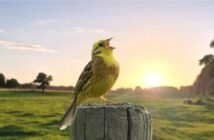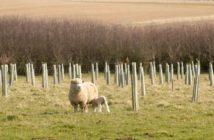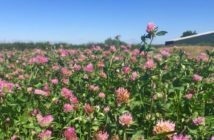Bee and butterfly numbers have slumped after a tenth year of unsettled weather, National Trust experts have said.
Mild winter and spring weather led to extremely high grass growth, leading to a good year for farmers with livestock and for making silage or hay. But the grass growth meant a difficult year for warmth-loving insects, including common meadowland butterflies.
The assessment comes as the National Trust marks ten years of its annual weather and wildlife review, which is aimed at understanding how changing weather patterns is affecting wildlife at its places.
The conservation charity is working with its tenants and partners to reverse the alarming decline in UK wildlife, with 56 per cent of species seeing their numbers fall in the last 50 years.
Matthew Oates, nature and wildlife specialist at the National Trust, said: “Another year of unsettled weather has seen extraordinary grass growth – good for livestock and hay making, but bad for many plants and insects which like short turf grassland, like the common blue butterfly.
“Our rangers have had to work closely with farmers and graziers to get grazing levels right for these plants and insects. In many places it’s been a struggle, but at a handful of places like Somerset’s Collard Hill – home to the large blue butterfly – graziers have triumphed.
“2016 comes on top of an unsettled decade, with many species struggling in the face of climate change and more intensive farming practices.”
A mild winter, cold spring and mild, wet weather in May and June led to very high grass growth in early summer. Grass grew at a rate almost a third faster than in previous years, according to Agriculture and Horticulture Development Board figures.
Rampant grass growth was good news for farmers making hay in many parts of the country.
At the National Trust’s Packwood House, Warwickshire, twice the number of hay bales were collected compared to the previous year.
Tenant farmers Roly and Camilla Puzey made 25 per cent more silage on Saddlescombe Farm, South Downs, as last year.
However, on the Hafod y Llan estate, Snowdonia, intermittent rain in early summer meant that farmers struggled to make either hay or silage.
But in much of the country strong grass growth badly affected butterfly and bee species reliant on small plants that were crowded out by vigorous-growing grasses.
At Lytes Cary bumblebee numbers plummeted as wildflowers in the field margins were outgrown by grasses. Surveys by volunteers on the Somerset estate showed an 85 per cent decline in bumblebee numbers compared to last year.
On Purbeck, Dorset, meadow butterflies struggled: marbled white numbers plummeted by 73 per cent compared to last year and volunteers saw 23 per cent fewer common blue butterflies.
Rob Havard, beef farmer and tenant at Croome Park, Worcestershire, said: “This year has been the second really good year for us in terms of grass growth.
“The warm weather in the summer encouraged a really good rate of grass growth and then as soon as it started to get a bit dry we had a little rain which was ideal to encourage further growth. We also enjoyed a variety of flowering plants as well.”
Rob, whose herd of 70 Aberdeen Angus cattle graze across 230 acres, added: “The autumn was also dry and warm, so although the grass didn’t grow as much there has still been plenty for our herd.
“This year we also saw plenty of activity in terms of wildlife with a good population of field voles which attracted kestrels and barn owls.”
An unsettled decade
In the past decade, National Trust nature experts have noticed that winters are becoming milder and summers wetter, which could have a devastating effect on warmth-loving insects, their bird and bat predators, and many low-growing plants. Over the last 50 years more than half of UK species have declined.
National Trust nature expert Matthew Oates said: “In the ten years we’ve been reviewing wildlife at our places we’ve noticed pulses of unsettled weather become the norm. We last enjoyed a good summer in 2006.
“Mild winters and periodically wet summers have seen common wasp numbers apparently slump in many parts of the country, along with common ‘meadowland’ insects like the common blue butterfly. This could have a knock on effect on the invertebrates, birds and bats that eat them. And what affects insects today could well affect us tomorrow.”
Climate change has had a clear effect on weather and wildlife in the last decade:
In ten years the growing season has extended by almost a month, the Met Office announced earlier this year. Both the Met Office and the World Meteorological Organization have predicted that 2016 will be the hottest year on record – the third year in a row of record-breaking surface global temperatures.
Warmer temperatures, higher levels of carbon dioxide in the atmosphere and a longer growing season are leading to vegetation growing more quickly. According to a study published in November, this increase in vegetation growth is also leading to a drop in the amount of CO2 in the atmosphere.
Common wasp numbers appear to have crashed in many districts in recent years, perhaps suffering during milder winters and wet springs.
Matthew Oates added: “Long term, changes in how we manage land has also led to wildlife declines – with more than half of species experiencing a drop in numbers in the last 50 years.
“But one of the great successes of the last decade have been the ways farmers and conservationists have worked together to reverse wildlife declines in many of our places.”
In south west England work by conservation charities and arable farmers to benefit wildlife have resulted in numbers of cirl bunting, a rare bird that has retreated to Devon and Cornwall, increase by over 800 per cent since 1989. 15 per cent of Britain’s cirl bunting population live on National Trust farms along the south west coast.
At Longmoor in the Lake District’s Ennerdale valley, grazing by rare-breed Longhorn cattle has provided the right wet grassland habitat for marsh fritillary butterflies. The threatened species is booming there, with larvae numbers up by 560 per cent in ten years.
2016: wildlife winners and losers
A good year for…
Farmers have been rewarded with a brilliant year for livestock grazing and silage and hay making. Mild winters resulted in strong grass growth, coupled with warm weather during late July and August. Our floodplain meadow at Packwood House, Warwickshire, produced twice the number of hay bales as it did last year.
The dry and mild autumn resulted in a good year for autumn colour in National Trust gardens.
Rangers report a bumper apple harvest, with a warm autumn and rain late in the season producing an exceptionally sweet and juicy crop – especially in the south west. Rachel Brewer, National Trust cider maker and ranger at Barrington Court, Somerset, said in October: “The apple juice this year is some of the best we’ve ever made.”
The long growing season has also benefitted damsons, acorns, hazelnuts and many other tree seeds. Rangers at Brockhampton, Herefordshire, sold more than 1.75 tonnes of damsons to visitors this autumn – making £600 more than last year to spend on conservation work in the estate’s orchards. It’s also been a good year for beech masts, although efforts at Felbrigg, Norfolk, to collect 10kg of the seeds on behalf of Kew Gardens’ Millennium Seed Bank were hampered by wet weather in October. Going into the winter, there’s a plentiful supply of fruits in hedges and woods for birds and mammals.
Wildlife and habitats in the north of England have recovered relatively well from the storms that caused widespread damage in the Lake District. In May, one ranger in Borrowdale found lampreys laying their eggs under gravel in a new stream that sprung up after the floods. Landslides at Allen Banks, Northumberland, closed the river gorge for eight months whilst ranger repaired paths and bridges; during the closure, otters were spotted on the river near the visitor centre for the first time in decades.
Birdwatchers have enjoyed the rare winter migrant birds that arrived on strong easterly winds. 220 goldcrests were spotted in a single day on the Farne Islands in October. In late October ranger Dougie Holden spotted an isabelline shrike at Souter & the Leas, near South Shields. The bird is believed to have been blown off-course during its annual migration from China and Mongolia to Africa and the Middle East.
It has been a boom year for marsh fritillary butterflies at some sites. In one Ennerdale field in the Lake District, webs were seen on most of the devils bit scabious, which the butterfly larvae rely on as a food-plant. Numbers boomed, forcing many to find new sites. Numbers were also very high at Calstone Coombes & Cherhill Downs in north Wiltshire.
Warm, blustery weather in Cambridgeshire in July, may have brought the Norfolk hawker dragonfly to Wicken Fen, near Ely. This was the first sighting at Wicken of the brown dragonfly, which normally lives on the Norfolk broads, since 1893.
By January this year, 2,342 grey seal pups had been born at Blakeney Point on the north Norfolk Coast. The colony has grown from just 100 pups in 2004. The Farne Islands have seen large numbers of grey seal pups born this year, with 1,879 pups counted by rangers by the end of November – exceeding last year’s seal pup total.
But a bad year for…
Rampant grass growth has hit butterflies and other insects that breed and feed on small herbs, grasses, and wildflowers that can’t compete with rampant coarse grasses. At Ballard Down on Dorset’s Isle of Purbeck, a cold spring meant numbers of early butterflies like orange tip and green hairstreak were below average – and no Brimstones were seen.
At Mountstewart, Co. Down, Speckled Wood butterflies have enjoyed a spectacular year; the butterfly lives on the fringes of wood and does relatively well in damper summers and poorly in drought years.
Rare arable plants have been squeezed out by heavy grass growth in much of the country. At Lytes Cary, Somerset, field margins planted with rare arable weeds like endangered Spreading hedge parsley and nationally-scarce Blue pimpernel were crowded out by rye and couch grasses. Bumblebee numbers in the field margins plummeted, with surveys showing a 85 per cent decline (from 112 to 16). Lytes Cary is one of the best sites in the South West for the UK’s rarest bumblebee – the shrill carder bee – and rangers are restoring meadows on the estate, which is already benefitting the bees (with sightings across the estate up from 104 in 2015 to 109 this year).
Meanwhile, on thinner soils and coastal areas it’s been a better year for wildflowers. Orchids have done well on the chalky soils at Box Hill, Surrey. Thanks to grazing by farmer James Mably’s cattle, plants like broad-fruited cornsalad are returning to Pentire Head, Cornwall. The cliff top farm was bought by the National Trust in 2015 and, according to Plantlife, is one of the best non-calcareous arable weed sites in the country.
Strong grass growth has also proven challenging for conservation grazing. Many farmers work with conservationists, to graze fields with particular livestock breeds or in particular way to benefit wildlife. This year animals have struggled to keep on top of the heavy grass growth. In Co. Down, Northern Ireland, more cattle have been put on the fields, in an attempt to take advantage of the excess grass.
An example of where it’s worked is Collard Hill, Somerset, where rangers have worked closely with grazier Pat Burrough, to get grass on the calcareous clay hillside to the right level for large Blue butterflies – one of Britain’s most endangered butterflies.
In many places it has been a poor year for the field vole, which goes through a 3-4 year cycle of boom and bust. 2016 seems to have been a deep trough in numbers in many places. Field voles are the fast food snack of choice for many of our most iconic predators, such as barn owls and kestrels. Without them barn owls do not breed well, with no barn owl broods at Malham in the Yorkshire Dales or Dyrham Park, near Bath. It is possible that the good grass growth has helped buffer the field voles’ trough, with kestrels spotted hunting in the parkland at Dyrham late in autumn.
Gardeners have battled slugs, which have enjoyed the mild and wet weather. At Attingham Park, near Shrewsbury, gardeners had to replant their dahlias three times, after slugs claimed the first two sets of plants.
A mild winter, followed by a hot spell in May and a cooler start to the summer proved confusing for Sycamore trees on the Dolmelynllyn Estate in Snowdonia. The trees began shedding their leaves in late July – perhaps thinking that the mix of weather meant that they’d already reached autumn.
Rangers and volunteers have struggled to control strong gorse and bramble growth. On the Northumberland Coast it is estimated that rangers spent an extra ten days cutting back brambles and nettles from footpaths. This was probably due more to the mild winter than the cool damp summer.
2016: pattern of the year
The year started wet, with January being the fourth wettest on record. It followed storms in December 2015 that caused widespread damage in the Lake District, where a foot of rain fell in just 24 hours: landslides closed Allen Banks in the North Pennines for eight months, as well as damaging veteran beech and oak trees.
A cold, wet spring followed by mild and wet weather in May and June to unprecedented grass growth in early summer.
Spells of hot weather in July and August provided much needed respite for many species. In July, a Norfolk Hawker Dragonfly was seen at Wicken Fen, Cambridgeshire, for the first time since 1893. The dragonflies are native to the Norfolk Broads, but appear to be moving westwards in search of other fenland habitats.
September 2016 was the second warmest since Met Office records began in 1910. And the warm autumn meant visitors to National Trust places were treated to stunning autumn colours, with Barry Smith, the Head Gardener at Stowe, Buckinghamshire, naming it “one of our best years for autumn colour”. Good conditions in autumn also meant an excellent year for apples, berries and nuts.
Unsettled weather continued into November, with a brief cold snap which brought four inches of snow to the Yorkshire Dales. At Hudswell Woods, near Richmond, the snow “came as a surprise to the wood”, said Ranger Seb Mankelow, as many of the trees were still in leaf.
Storm Angus caused localised flooding across the west of the country in late November. However, the Exmoor villages of Bossington and Allerford did not flood – despite river levels rising by half a metre in two hours. Managers on the National Trust’s Holnicote Estate, Somerset, have worked with local farmers and Defra to install natural flood defences – planting trees and restoring water meadows capable of storing millions of litres of floodwater.
The picture shows a common blue butterfly. Credit Matthew Oates/National Trust Images




